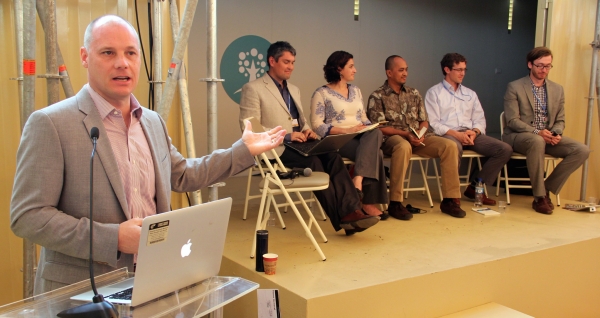
19 December 2014
On the 2nd and 3rd of December The Forests Dialogue presented at two side-events during the COP20 in Lima, Peru, on REDD+ Benefit Sharing. These events were complementary to the release of the latest TFD review on the topic and a more specific report on the country options for Peru. To enrich the conversation TFD in collaboration with IUCN invited panelists from all over the world to talk about REDD+ Benefit Sharing.
.@GDunningTFD "Most exciting part of #REDD dialogue was revealing learnings from populations impacted on the ground."
— The Forests Dialogue (@forestsdialogue) December 3, 2014
Linking Policy and Practice: Approaches to REDD+ Benefit Sharing
During the first panel the broader implications of REDD+ Benefit Sharing were explored. Gary Dunning started off by giving a presentation explaining what TFD is, how it works and where in the context of REDD+ it was been working. Moderated by Patrick Wylie from IUCN, the participants each explained their take on the issue. Percy Summers from Conservation International Peru, who presented on the Alto Mayo Case Study, emphasized the need to match the REDD+ tools to the specific context.
Leticia Gutierrez Lorandi from The Nature Conservancy Mexico showed on the example of Mexico how rural sustainable development can be accelerated though the landscapes approach. While a large part of the discussion focused property issues and how to scale up REDD+ from pilot projects to a national scale, Iwan Wibisono from the Indonesian REDD+ National Task Force explained the necessity of a close relationship and cooperation with the private sector in order to make REDD+ a success which was supported by Chris Meyer from the Environmental Defense Fund by asking how businesses can be a tool for progress and resolution.
Sharing the Benefits of REDD+ - The Case of Peru
On the second day TFD and participants dived in deeper into REDD+ Benefit Sharing, looking at the implications for a specific country: Peru. Our Peru dialogue in February 2014 took place in San Martin in the Bosque de Proteccion Alto Mayo. The big question was how to design and implement REDD+ Benefit Sharing in Peru. Moderated by Doris Cadero from IUCN, Gustavo Suarez de Freitas from the „Ministerio del Ambiente" (MINAM) started the panel off by criticizing the property rights issues that have been holding back the REDD+ process in the past.
"Most deforestation happens where clear rights are not well established.“Gustavo Suarez de Freitas, MINAM
He furthermore emphasized that we need to be careful with the definition of REDD+ Benefits since they may not always come in the form of money. Percy Summers from Conservation International Peru described the work with local stakeholders to establish a strategy for a protected area with a high rate of deforestation. Like the day before, Summers pointed out that such a process cannot be done without realizing that REDD+ can never be the only tool in the box to achieve conservation. Many other policy instruments can cover areas REDD+ may not have the most optimal rules on.
Patricia I. Fernández-Dávila from CIMA-Cordillera Azul also worked on deforestation issues and realized that populations in buffer zones can be effective allies at avoiding deforestation.
This event was covered in collaboration with the International Institute for Sustainable Development. For a summary of the event by IISD, go here
Find the TFD Review on REDD+ Benefit Sharing here
Find the shorter Handbook on Country Options for REDD+ Benefit-Sharing here
Find the TFD Country Report on REDD+ Benefit Sharing in Peru here
